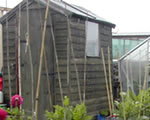 Go to main content
Go to main content
Archive Website of the UK government
Please note that this website has a UK government accesskeys system.
Main menu
Page menu
Environment and greener living

Sheds, greenhouses and garden furniture: greener choices

There are many ways you can help the environment while getting the most out of your garden. Choosing sheds and garden furniture made from sustainably produced wood, cutting out greenhouse heating and choosing paints and varnishes carefully can all help.
The wider issue
Fuel burned to heat greenhouses creates emissions of carbon dioxide – the main greenhouse gas that contributes to climate change.
In addition, some sheds and garden furniture are made from wood which has been logged illegally. Illegal logging of rainforest hardwoods contributes to deforestation, which currently accounts for 20 per cent of global carbon emissions. This is more than the entire global transport sector produces. For more on deforestation, see 'Causes of climate change'.
Choose sustainable materials for sheds and furniture
Some popular woods for sheds and garden furniture are harvested unsustainably – and sometimes illegally – from ancient forests.
It’s easy to find sustainable timber products in high street retailers. Look for a label from a reliable certification scheme like the Forest Stewardship Council (FSC) or Programme for the Endorsement of Forest Certification schemes (PEFC).
You could also ask your retailer if they stock certified timber products. The Central Point of Expertise on Timber Procurement (CPET) lists reliable certification schemes and examples of labels on its website.
Cut out greenhouse heating
If you’re using a greenhouse to grow fruit and vegetables, you’re helping the environment by reducing the energy needed to transport and store food.
However, heating a greenhouse in the winter months can be wasteful. Greenhouses are poorly insulated and heating them uses energy, which contributes to climate change. Taking care when setting up and using your greenhouse could eliminate the need for winter heating altogether:
- keep your greenhouse glass clean, especially where panes overlap; even normal grime will dramatically reduce light levels and cut down on free heating from sunlight
- place your greenhouse in a bright spot that gets sun all day and isn’t shaded by trees or walls
- a lean-to greenhouse that shares a wall with your house will need less heating
- free-standing greenhouses with the lower part made of brick or timber conserve heat better than all-glass models
- seal gaps around poorly-fitting panes or doors to stop heat escaping
- consider moving less hardy plants indoors for the winter instead of heating the whole greenhouse for their sakes
Choose coatings carefully
Varnishes, paints and wood treatments used on fences and outdoor furniture often contain volatile organic compounds (VOCs). These cause air pollution and may be harmful to human health, animals and plants.
When you're choosing a paint, varnish or wood treatment, try to find one with the lowest impact possible for the job you're doing:
- product labels should show the VOC content; choose the option with the lowest VOC content
- ‘natural’ or ‘all natural’ paints, milk paints and white washes have a lower impact than ordinary paint
- check to see if there is a hazard warning on the product label - if you have a choice, choose a product without a hazard warning
- never pour waste coatings (paints, varnishes and wood treatments) down the drain, as they can be hazardous - contact your council for guidance on disposal
- consider oiling wood products instead of painting them
Use reclaimed and recycled materials
Using reclaimed or recycled materials will help save raw materials and energy used to make new items, and reduce waste:
- if you’re planning decking or wooden planters, consider using reclaimed timber from a timber yard
- improvise plant containers from interesting or unusual discarded objects like baths, sinks or old copper pans
- choose reclaimed cast iron ornaments, if possible
- look out for products labelled as using recycled wood, metal or plastic
Encourage wildlife with your shed or garage
Encourage moss and other plants to grow on the roof of your shed or garage – flat roofs are particularly well suited. A living roof can:
- insulate the room below, saving energy on heating and cooling
- provide a habitat for insects and other wildlife
- improve the appearance of the building
Sheds and other garden buildings can be used to create space for wildlife in other ways, for example by putting up nesting boxes or encouraging climbing plants.
If you can’t download the PDF file via the following link, it may be available as a leaflet from: Natural England, Enquiry Service, Northminster House, Peterborough, PE1 1UA. Telephone 0845 600 3078 or email: enquiries@naturalengland.org.uk
 Facebook
Facebook Twitter
Twitter StumbleUpon
StumbleUpon Delicious
Delicious Reddit
Reddit
